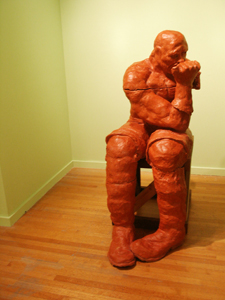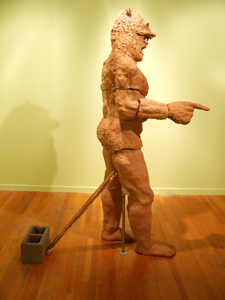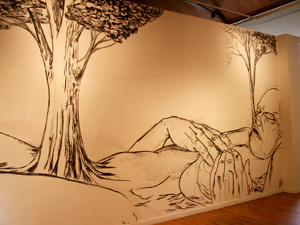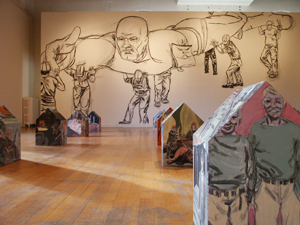
|
||
|
Portland art blog + news + exhibition reviews + galleries + contemporary northwest art
|
||
Daniel Duford's Sleeping Giant at the Art Gym Daniel Duford's new work at the Art Gym explores the interaction between architecture and American cultural mythology as represented by comic books in Sleeping Giant.
The flyer published by the Art Gym contains a 2-page spread of a Sleeping Giant comic. This brief narrative seems to be a component of a larger story. It relies on a "nature as cataclysm" theme which parallels Alan Moore's famous Swamp Thing, as well as the pre-heroic Sub- Mariner. Sub-Mariner was the main character of the first Marvel Comic ever published, and his original intention was the oceanic destruction of New York City until the appearance of Adolph Hitler during WWII as an eclipsing super villain in the Marvel Universe caused him to reevaluate his moral position. 
Duford's aesthetic is a mixture of the Golem myth and the "big" superhero. "Big" superheroes are incarnations of the id: they have become so physically energized that the power of their aggressive tendencies is nearly uncontrollable, and often supercedes intellect and judgement. These heroes represent an opportunity for writers to grapple with moral and existential dilemmas, and it is often difficult to establish whether or not they are heroes. Of course, it was Alan Moore and Berni Wrightson's Swamp Thing which brought a new level of sophistication to the "Big" hero. In Swamp Thing, the hero's "bigness" became spiritual "vastness." Swamp Thing was not an incarnation of the id, but rather an incarnation of Nature itself, and he struggled not against his own aggressive desires, but against the brutal imposition of control on the delicate complexity of the natural world. This discussion is not tangential in examining Duford's work, but merely an elaboration of the artistic precedent for Sleeping Giant. Just as in examining art we often look to art history, in examining comics, we look to the art history of comics. However, I'm sure summarizing the Swamp Thing can be little more than an academic exercise for readers already immersed in Portland's vigorous comic culture. One of Duford's wall drawings seems especially related to the conceptual locus of Swamp Thing, and is emblematic of the Sleeping Giant myth. The body of the Sleeping Giant suddenly coheres from what previously seemed to be a landscape. As the Giant stirs, his nose and penis grow into giant trees. In the comic, a thought balloon reads, "I am the Tree of the World. I must rise up once again." The giant's proximity to a small American town creates an energy nexus. The town becomes the "center of the universe" The continent starting over. Duford channels the spiritual vastness expressed in the Swamp Thing into "Americanness". So the Sleeping Giant then, while drawing from its predecessor, moves into the realm of American Mythos. Duford's Giant is more akin to legends of vastness which fix the American Landscape within the American cultural consciousness and its divine mandate of Manifest destiny. Sleeping Giant is another, stranger manifestation of the myths already prolific in the American mind; myths which assert that we are a people chosen by God, given a bountiful land in which to pursue our dreams to the utmost. In this model, Nature becomes part of a larger, invisible ethical system. Duford's Giant then, can be seen as less Swamp Thing (pure nature) and more Paul Bunyan or Johnny Appleseed, both myths developed for assimilating nature into the American cultural-ethical program. The relationship between the one-armed superhero and the Sleeping Giant remains unsolved. The one-armed superhero is clearly a distinct character from the Giant. The Giant seems immobile and inseparable from the landscape itself, while the superhero has individual agency. He flies through the branches of the Giant's tree and walks through the streets of the town. The one-armed superhero seems to also be a giant, although in one of the murals, he is miniaturized and seems to be afraid of being stepped on by two larger people. In the comic he moves with strident intention, but seems to be aimless. In the final panel, the viewer is dwarfed by a low POV while the superhero ruminates rather than acts: "Why did I return to this crushing banality, this moral absolutism?" Hesitance and rumination seem to be the central principles of this character. These principles reach their apex in the larger than life size terra-cotta sculpture set apart in the room painted chartreuse at the Art Gym. The one-armed hero (who may or may not be the Sleeping Giant himself) appears in a life size figurative sculpture responding to Rodin's iconic Thinker. If it can be said that The Thinker represents the intellect as a sublime, heroic quality, and human reason as the central axis of existence, the one-armed hero represents an anti-thinker, frustrated and powerless, his single hand playing nervously over his face as he looks over his shoulder in a state of paralytic anxiety. His feet are dismorphic and clumsy and one foot crushes the other in his agitation. This is a being profoundly incapable of decision or action, his superhero costume only highlights his incapacity. It must be noted in drawing comparisons to Rodin that his sculpture was not in fact originally intended as the icon of intellect it has since become. Rodin himself titled the sculpture The Poet, and it represents Dante, and the existential torment he endured in envisioning the nine circles of Hell. Looking at Rodin's sculpture, one must try to dissolve the cultural baggage it has acquired and see it as it actually is: deeply conflicted, a lucid portrait of interior spiritual turmoil. Duford's statue actually parallels the intended themes of The Thinker, even while it opposes the themes that that work has since acquired. The life size terracotta statues lead us into Duford's Golem aesthetic. Of note is that the Yiddish word Golyem means shapeless mass. The materials themselves hold great significance in the Golem myth. The Golem must be made from clay, not carved, because clay was the same substance from which God created Adam. Adam was created in God's image and the Golem was a flawed duplication of man's image, a corrupt iteration three times removed from God Himself. The rabbi animates the Golem by writing the secret name of God on a slip of paper and placing it in the Golem's mouth. But man's creation is necessarily flawed, and becomes a brutal, careless destroyer rather than the protector originally envisioned. It is simple to splice the Golem myth into the "Big" Superhero myth and Duford accomplishes this with a sure mastery. The application of the Golem myth is what renders the "Big" Superhero helpless and ineffective, for the Golem myth tells the story of untempered brutality, which can only end by the destruction of the avatar, made of a curiously fragile material. Incidentally, and beautifully, this is exactly what happened to a previous suite of outdoor Golem sculptures at the hands of vandals. So the Golem myth provides the "Big" superhero with a final resolution to the endless conflict between the id and social/ rational self: suicide. Paralyzed by this realization, Duford's one-armed superhero buys himself a few more precious moments of life through tortured self-analyzing hesitation. 
Standing in the center of the chartreuse room, a few feet from the seated thinker, is a Golemic portrait of a bear-shaman character from one of Duford's other books, Naked Boy. The bear-shaman character (I think) is an avatar of the American wild drawn from aboriginal American myth. Simultaneously, it evokes Archaic Greek sculptures of Hercules wearing the skin of the Nemean lion. This association becomes especially solid when one notices the shaman steps forward without shifting his weight, instead he remains upright while his leg lengthens. This of course is an identifying quality of Archaic Greek Kouros. The Shaman wears a bear skin as ceremonial regalia and points accusingly as he strides forward. Components are separately fired and assembled, and there are huge gaps between the sections, through which one can see that the hollow statue is filled with bricks, weighting it in place. A steel pole props the shaman upright and enters the right leg amidst a messy glob of silicon glue. Here Duford gives no concessions to illusion, and the pole and the glue are undisguised hardware materials. Behind the steel pole support is a wooden 2x4 prop with one end against the leg and the other wedged behind a cinder block on the floor. In examining these support structures, I noticed that this wooden prop actually carries none of the weight of the piece. I could be wrong about this, but it seems to be a gesture on the part of the artist to emphasize the immediacy of the construction. In keeping with the Golem myth, this object is created in response to an urgent physical need rather than as the fruition of an intricate artistic exploration. This piece elaborates Duford's Golem aesthetic but the aggressive gesture of the avatar is less interesting to me than the complex interiorality evoked in the Thinker/ one-armed superhero. In addition the publication states that "Duford is staging a narrative and coaxing the viewer to become a player on that stage." I am unsure if this is curatorial writing or Duford's own artist statement for the show. Regardless, I am interested in the possibility this suggests of a "narrative environment", or as I would phrase it "text as architecture". Elsewhere in the show, Duford successfully creates this effect, but in this instance, although arguments can be made for the sculptures as autonomous elements, I find it disruptive to include a central character from another narrative entirely. I suppose from a curatorial perspective, this show could be seen as a collection of Duford's recent work, but the idea of a "narrative environment" holds so much promise and excitement, I feel this show would have benefited from more carefully editing and precisely constructing that environment. Maybe I'm too particular in this regard, but in many instances of this show, the environment itself tells a story, and the viewer really feels like a comic book has been translated into architecture, and these are Sleeping Giant's best moments. That being said, I must make the concession that the Bear Shaman seems superficially related to the Sleeping Giant narrative, as he too is missing an arm. Perhaps these different narratives exist in a cohesive universe, much like separate comic characters exist together in the Marvel Universe, or perhaps the Bear Shaman and the Sleeping Giant are equivocal avatars appearing in separate narratives... It remains unsolved. This same problem occurs in the back corner of the gallery, where Duford's sexualized action figures, despite having a complex aesthetic all their own, are utterly unrelated to the larger narrative environment. In this context, they seem overshadowed and irrelevant, which is really a shame, because this work is genuinely peculiar and impishly funny. I won't elaborate on the action figures here, although some of you may care to in the comments. I feel these pieces would have been better left out of the show, as they were so completely eclipsed by the other work. 
In the main room of the Art Gym, Duford expands single panels of the Sleeping Giant narrative into mural size charcoal wall drawings. Once again, the material itself is important to the Golem Aesthetic: charcoal has an indelible brutality, an alchemical primacy. The events in the comic occur in the main room. The charcoal murals represent the peregrinations of the one-armed super hero and the resurrection of the Sleeping Giant himself, the World Tree whose nose and penis grow into giant spreading oaks. The town which becomes the new origin point of mytho-cultural America is represented by a series of identical wooden house forms in a perfect grid on the gallery floor. On each surface of each house- object is a drawing in paint of a partial comic panel. 
Because the walls are also comic panels, there is a sublime moment of tension between architecture and observation which is the greatest strength of this work. As the viewer engages the flat comic panels painted on the surfaces of the small houses they suddenly experience that something-over-the-shoulder feeling to see the same kind of flat comic panel drawings imposed on the architecture of the gallery which surrounds them. This is a sort of mirror-reflected-in-another-mirror tension between viewer and object, between flatness and space. As the viewer reads the flat narrative on the houses, it is as if they too are being read by the larger narrative on the walls of the gallery. Although I appreciate the immediacy and brutality of the charcoal drawings, and I think this show on the whole is quite daring, maybe because I was thinking about Swamp Thing I found myself longing for Berni Wrightson-like density in the wall drawings. The effect of being "read by the story" would have been far more profound if the drawings weren't quite so loose. The looseness and speed of the drawings offered an easy escape from the disconcerting effect of being "trapped in a comic book". Although, inarguably line is the main component of comic art, I think solid values are nearly as important as line. Duford's limitation of only using line in the wall drawings seemed like a missed opportunity. Values created with charcoal can have spectacular density, and it would have solidified the effect of an architectural comic panel. Although perhaps line alone, applied with a Wrightsonesque horror vacui would have also potently ensnared the viewer in the narrative. As it was, it was a slightly too-facile approach to a complex idea that could have been more potently realized. I don't mean to say here that the show is by any measure a failure in terms of its intentions. It is complex and daring. Just the act of drawing on the gallery wall with charcoal has a kind of spirited recklessness I admire. That isn't something you can sell, after all, you just wash it off. (Ok, I'm getting into trouble by equating not selling with artistic daring, and I admit to having a kind of bias that way....) I mean to suggest that what is strong about the work could be stronger, and the work's potential didn't seem fully realized. Although I must concede washing a dense field of charcoal off of a gallery wall seems just as daunting for the curators as creating it would be for the artist. Overall, the main room seems more like a sketch for a "comic as architecture" I think it could be improved by moving it towards the feeling of a fully penciled and inked panel. And for that matter, I saw no reason to exclude text from the main room. In comics, text is more important than images in sustaining narrative, and the appearance of enlarged text in the murals would have further secured the viewer's position as part of the narrative. Also, the greatest strength of the two page Sleeping Giant comic reproduced in the flyer is Duford's poetic mastery of comic language. Duford's text constructions are lyrical, rhythmically terse and create resonant, multi-layered systems of meaning which must be interpreted by the viewer in order to be understood. Elaborate tensions arise in the comic in attempting to assemble meaning between the text and the images, and in my opinion, the murals could only benefit from the inclusion of this further layer of complexity. Of course in complicating and disrupting the interaction between text and image within a comic panel, Duford reveals a connection to the work of Raymond Pettibone. But viewing this connection as detractive from Duford's work seems narrow. Comics are an arena in which text and image are inextricably interdependent, and a perfect, limited environment for complex semiotic exploration. I don't think the extent of this terrain has been mapped so thoroughly by Pettibone's work that it cannot be explored by other imaginations, and Duford's mythic subject matter differentiates him from Pettibone's punk rock aesthetic. In fact, Duford's language is as clearly related to James Joyce as it is to Pettibone. And the beauty of comics, after all, is that they provide an arena with clear limitations. Operating within the boundaries of those limitations, the narrative possibilities are endless. I'll end with a passage of Duford's evocative prose: Our young men, our heroes go out in droves. Oh, those sinews! That marrow deep resolve! They are our best hope - bred to work, to thresh. Oh, Great Innovators! Posted by Isaac Peterson on January 18, 2006 at 23:36 | Comments (2) Comments ...a good show and the golem characters no longer looked like the Concrete character as it did in previous shows. It's an ambitious step up, but I found the political element to be too stereotypical. When Norbert Bisky paints blond, slightly fascist kids it's more open-ended and has a bit more of a signature visual style. I also felt like too many narrative directions were pursued and just three well developed ones would have made it richer. It needs editing but working this large for the first time the hedging is understandable. Also, the only political art that ages well is the very open-ended stuff like William, Pope L., Leon Golub, Georg Baselitz or Klee and this show seemed sooo calibrated to America October 2005. It plays a familiar politically oriented tune (toon) that affirms but doesn’t really reflexively challenge the political slant it presents. I liked it because it affirms a lot of sterotypes I and most other arty types hold but intellectually it felt like it was preaching to the chorus. Look to Sam Durant's latest work, he now purposefully confounds icons and their politics. Posted by: Double J It's funny, because part of the reason I really enjoyed this show is because of the varied pieces in it, but then again I can also understand how this hurt the show as well. I think my weakness in "critiquing" this show is that I was unable to seperate the information I previously knew about Duford's work, from what was actually before my eyes in the gallery. Overall, I would say great show. I personally enjoy the rough line work of tthe comics. I think that is the part I really enjoy about them is the immediacy of the line. It looks playful, yet unrefined enough to the point where it just makes the image look neglected and uncared for. Posted by: Calvin Carl Post a comment Thanks for signing in, . Now you can comment. (sign out)
(If you haven't left a comment here before, you may need to be approved by
the site owner before your comment will appear. Until then, it won't appear
on the entry. Thanks for waiting.)
|
| s p o n s o r s |
 |
 |
 |
 |
 |
 |
 |
 |
 |
 |
 |
 |
 |
 |

|
Site Design: Jennifer Armbrust | • | Site Development: Philippe Blanc & Katherine Bovee | |


![[TypeKey Profile Page]](http://www.portlandart.net/nav-commenters.gif)